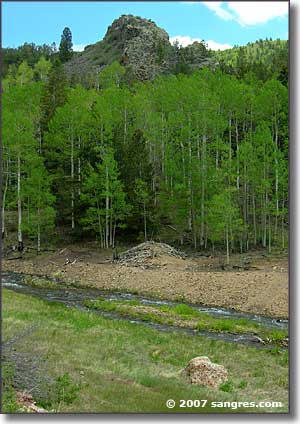
Bonanza, Colorado

Heading north up the valley to Bonanza

In 1865, at the end of the Civil War, quite a few Colorado veterans settled in the Bonanza area on land given them by the Federal Government. One of these veterans was a "Lt. Kerber" and Kerber Creek and Kerber City were named for him. Life was probably pretty peaceful and quiet until 1880 when the first silver strike occurred upstream from Kerber City. Supposedly, one of the original miners made a comment about "this is going to be a bonanza," and that name stuck for the town that grew up there (but it was no bonanza: no millionaires were created by any of the mining in the district).
Since that time, Bonanza has been the center of the 30-square-mile Kerber Creek Mining District. In the best of times, Bonanza had more than 500 citizens with several saloons, hotels, a Town Hall, a schoolhouse, a daily newspaper and a house full of "fancy ladies." Bonanza even had a community theater and its' own baseball team. One thing Bonanza never had, though, is a church.
There are more than 80 named mines in the Kerber Creek Mining District. Over time, big mines would play out, the population would drop to maybe 100 people and these folks would wait for the next wave of "eastern investors" to put up some money and start the next mining boom. The last boom happened in the early 1920's when someone located profitable ore in the Rawley Mine. This boom saw the construction of a new mill in Squirrel Gulch and a 7-mile aerial tramway to carry concentrated ore over the mountains to a narrow gauge railroad at Shirley. This vein of ore played out in 1930 and Bonanza has been dwindling away since then. Most of the original buildings in town were destroyed in a fire in 1937.
All this mining near Bonanza has left a legacy of environmental problems. The high metal content of water flowing out of mine tunnels and seeping out of tailing piles, plus the high acid levels in the water running off the old mining sites has led to miles of "dead" fish and aquatic-insect habitat in Kerber and Squirrel Creeks as far downstream as Villa Grove. In 1994, the State of Colorado, the National Forest Service and several private parties began a program of environmental cleanup along Kerber Creek. The first site addressed was the old Rawley Mill where 32,000 tons of tailings were removed and hauled 5 miles to a State-approved repository. Rehabilitation work continues at a number of sites within the historic Kerber Creek Mining District in an effort to improve water quality.

Still south of Bonanza

ED Loghouse, just south of Bonanza

An old tailings' mill south of town

These things are all around

In the Bonanza townsite

You know this was an old mining town

The stone siding is actually painted on

Some places are in pretty good shape

The original Kerber City townsite

More tailing mills and placer mining locations, downstream from Bonanza
Latitude: 38.2951°N
Longitude: 106.1402°W
Incorporated: 1881
Elevation: 9,478'
Education:
High School or Higher: 66.7%
Bachelor's Degree or Higher: 23.8%
Graduate or Professional Degree: 14.3%
Median Resident Age: 44.5 Years
Estimated Median Household Income: $12,900
Estimated Median Home Value: $83,800
2011 Cost of Living Index for Bonanza: 90.3
Unemployed (March 2011): 12.8%
Population Demographics: 2010
| Total Population | 16 |
| Males | 10 |
| Females | 6 |
| Population by Age | |
| Under 18 | 0 |
| 18 & over | 16 |
| 20-24 | 1 |
| 25-34 | 0 |
| 35-49 | 4 |
| 50-64 | 5 |
| 65 & over | 6 |
| Population by Ethnicity | |
| Hispanic or Latino | 0 |
| Non Hispanic or Latino | 16 |
| Population by Race | |
| White | 16 |
| African-American | 0 |
| Asian | 0 |
| Native American | 0 |
| Hawaiian or Pacific Islander | 0 |
| Other | 0 |
| Two or more | 0 |
Rio Grande National Forest - State Trustlands & Wildlife Areas
La Garita Natural Arch - Penitente Canyon - Russell Lakes SWA
Cochetopa Hills 1 - Cochetopa Hills 2 - Joyful Journey Hot Springs Spa
Mountains
Sangre de Cristo Mountains - Sawatch Mountains - San Juan Mountains
The Crestones - Kit Carson Peak - Panoramas: Sangre de Cristo Mountains
National Park Service Sites - BLM Sites - National Wilderness Areas - Unique Natural Features
Outdoor Sports & Recreation - Ski & Snowboard Areas - Photo Galleries - Colorado Mountains
